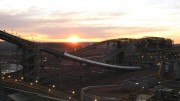Unto everything there is a season; a time to hustle and sell off your vast, frozen iron ore assets in remote parts of the country to foreigners from the tropics, and a time to throttle back production at actual iron ore mines in Canada’s hinterland so you don’t go broke.
The painful turn taken by Toronto-based junior iron ore miner Labrador Iron Mines (LIM) is emblematic of the cold winds blowing through the iron ore markets these days with iron ore prices straddling US$100 per tonne, compared to the easy livin’ summertime of early 2011, when prices were settled in around US$180 per tonne.
Coming into production just as iron ore prices have tanked, Canada’s newest and only independently owned iron ore miner LIM is showing once again why there are so few junior producers in this investment space — it’s just that difficult for a one-horse junior to survive the inevitable booms and busts of a subsector with such enormous scale and capital needs as iron ore mining.
LIM shares have sunk to the $1 range from $14 in the first half of 2011, and the company is financially battening down the hatches as winter comes down hard on its Schefferville projects in the west-central part of the iron-rich Labrador Trough. LIM raised $30 million recently, but is delaying for some of its boldest development projects in the region.
The good news is that it looks like the fall in iron ore prices has stabilized. The September announcement of another round of stimulus spending by the Chinese government in the form of a US$160-billion infrastructure program has had a salutary effect on iron ore prices that looks like the start of a turnaround, and Chinese import prices are suggesting that a longer-term floor of US$120 per tonne of iron ore is reasonable.
Another good development for Canadian operations is the deferral this year of several iron ore projects in Western Australia, which will help cool down some of the over exuberance on iron ore’s supply side.
• Shed a tear for the poor mining exec in Toronto or Vancouver, who may have to delay putting in that new wing on the mansion in Rosedale or North Vancouver.
Vancouver-based Coopers Consulting and its partner PwC have come out with their latest annual survey that finds Canadian mining company CEOs have watched their average total cash compensation tumble this year, with average base pay rates flat since 2011, but annual bonuses chopped substantially.
The study shows that the Canadian mining CEO’s average total cash compensation package was $767,000 in 2012, down 7% from $826,000 in 2011. Coopers and PwC note that the average annual base salary was almost unchanged at $490,000 in 2012, but bonuses paid this year dropped 31% to $370,000 from the $540,000 in 2011, with the average bonus being 67% of base salary.
Survey leader Lou Vujanich of Coopers and contributor Michael Cinnamond of PwC blame the shrinking paycheques on a host of factors: board compensation committees’ implementation of “refined performance criteria for CEOs over the last several years”; a “greater emphasis on the variable equity based component” of the overall CEO compensation; and softer commodities prices resulting in lower profits and market caps of many mining companies.
Furthermore, Coopers and PwC’s study finds that, across a full range of salaried staff positions at a mine site in 2012, “over eighty percent of positions continue to be eligible for some form of incentive plan,” up from only 59% a decade ago. This, they say, is a “reflection of the continued fierce competition to attract and retain qualified mining professionals.”
New graduate mining engineers, the study finds, can “reasonably expect a starting salary in the range of $70,000” — a figure that rises to $76,000 in two years, with fully qualified mining engineers “potentially earning an annual base pay in the vicinity of $90,000.”
Lastly, by region, the study finds that Western Canadian mining operations “generally pay more than their Eastern Canada counterparts,” and that companies that “mine coal, industrial and other minerals generally pay more across the board, while base metal mining operations generally pay less.”
For info on how to get the full study, contact: Lou Vujanich at lou.vujanich@coopersconsulting.com.


Be the first to comment on "Editorial: Iron ore market gets anemic"